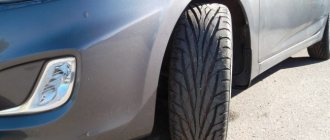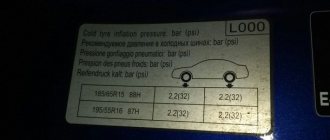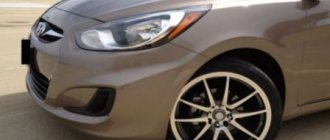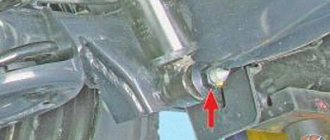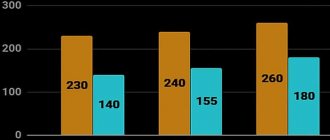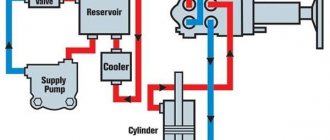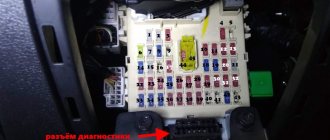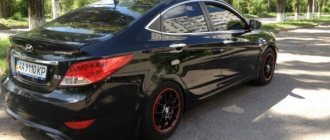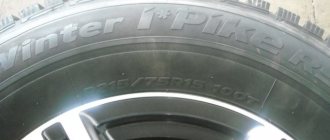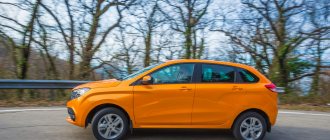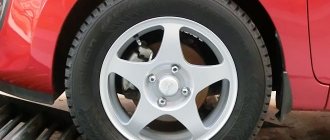For owners and buyers of any car, new or not, a number of questions about its maintenance are always relevant. And those who take the time to be diligent in finding the answers usually reap the bonus of hassle-free ownership, no nasty surprises like unscheduled repairs or deterioration, and saving money. Tires for Hyundai Solaris are in demand all year round, especially during seasonal shoe changes. The correct choice of wheels will have a positive effect on many characteristics of the car, such as handling, driving comfort, safety, chassis service life and some others. And, of course, the appearance, where would we be without it - properly selected rims can make the Solaris more sporty and interesting, giving it a significant amount of individuality.
Hyundai Solaris 2022 with original wheels
Tire and wheel size
The main characteristic when choosing wheels for Solaris is the size. It consists of several numbers - wheel and tire sizes. These characteristics may vary. New cars usually have wheel sizes that vary depending on the modification and configuration. The size of the disk is indicated by two numbers of the form 15 × 5.5, where the first shows the diameter in inches, and the second the width. The width is also measured in inches and its designation may also contain a Latin letter, indicating the design feature of the edge of the edge of the disk. For most modern passenger cars, this is the letter J. This feature provides little useful information when choosing wheels and is usually of interest to specialists. Most often, the following sizes of rims are installed on Solaris:
Another important point is disc ejection. It is marked with the letters ET and shows the distance between the plane that is pressed against the hub and the axis of symmetry of the disk. The offset can be positive, negative or zero. For Hyundai Solaris, the disc offset should remain within 46-52. When choosing wheels you should always pay attention to this parameter. It is allowed to change it by no more than 5-7 mm, relative to the factory one. Significant deviations in the offset value will negatively affect the vehicle’s handling and suspension life. In addition, wheels with an offset different from the specified one may simply not be suitable.
Solaris tire size is another important characteristic when choosing wheels. It is indicated by a marking of the form 185/65 R15, where the number 185 indicates the width of the tire in millimeters, 65 is the percentage ratio of the profile height to the width, the number 15 indicates that such a tire is intended for a rim with a diameter of 15 inches. The letter R indicates that the tire has a radial design; for modern passenger cars, at the moment almost all tires are of this design, so it is not an important parameter.
The most common Solaris tire sizes are 185/65 R15 and 195/55 R16. Such tires, depending on the configuration, can be installed on these vehicles at the factory.
For tuning, you can install larger wheels with a diameter of 17. However, here it is worth paying special attention to both wheels and tires. There are positive examples of installing 17″ wheels, 7.5J wide with ET45 offset. In this case, you can take 215/45 tires. Close to the ideal option with a narrower 6-7J wheel, such wheels practically do not protrude from the arches and look very harmonious. Difficulties when installing 17-diameter wheels can be created by fender liners, which reduce the space in the arches. Oversized wheels can catch on them. Such inconveniences can also occur without wheel arch liners when the steering wheel is turned completely or when driving over large bumps.
Solaris on 17 wheels and low profile tires
When creating this model, Hyundai engineers paid great attention to fuel consumption. In their opinion, this characteristic is more important for a city car than a sporty appearance and outstanding handling at high speeds. They chose wheels of small diameter and small width for a reason. They have a low weight and low rolling resistance, which has a positive effect on dynamics and efficiency. Installing wheels with a larger mass will have the opposite effect, to a greater extent this applies to Solaris with a 1.4 liter engine, which do not suffer from excess power.
Decoding disk markings
For example, R17 4×100 5.5J ET46
- PCD (Pitch Circle Diameter) diameter of the center circle of the mounting holes: 87 mm;
- Disk radius at 17;
- Drilling: number of holes 4;
- Fastening type: M10 – stud diameter;
- Thread size (pitch): 1.25;
- Center hole diameter: 57 mm;
- Pressure (front / rear): 2.0 / 2.1 bar.
The PCD value is calculated by the distance between the centers of opposite holes. We measure with a ruler, but do not dismantle the wheel. For four bolt construction, the PCD corresponds to the actual distance.
Rim offset is indicated by “ET”, the unit of measurement is millimeters. This is the distance between the point of contact between the disc and the hub and the middle of the rim width.
In different countries the designation is different: DEPORT, OFFSET. The offset is positive if the plane does not extend beyond the point of contact, otherwise the offset is negative.
The further the rim is from the body, the more the offset tends to zero.
- D is the diameter of the central hole, measured in millimeters.
- J, H and subsequent alphabetical symbols indicate the markings of the humps on the rim flange. Symmetrical, asymmetrical and combined.
- The “Hump” is a protrusion on the rim for a tubeless tire. When moving, the “rails” hold the tire beads, preventing depressurization.
Numerical characters indicate the release date, month, year.
- TUV is an abbreviation for the regulatory authority for compliance with quality standards.
Maximum wheel load: the unit of measurement depends on the country of manufacture of the rubber and rim.
Wheel bolt pattern
The bolt pattern of the Hyundai Solaris is another important point when choosing wheels. This parameter is sometimes also called drilling. It consists of two numbers of the form X*X and is denoted by the abbreviation PCD in disc labeling. Shows the number of bolts on which the wheel is attached and the diameter of the circle on which they are located. On passenger cars, four to six studs are typically used.
For Solaris, the PCD value is 4*100, which means that the wheel is mounted on four bolts located on a circle with a diameter of 100 mm. The wheels of the Kia Rio, a classmate from another Korean manufacturer, have the same bolt pattern. The hub hole in the disk has a diameter of 54.1 mm, the thread on the studs is M12*1.50. This type of thread is widespread and is found on many cars. Its value should help when choosing flare nuts for securing wheels. The hub hole may be larger than specified.
How the pressure sensor works, how to turn it off
Starting from the second generation, Hyundai Solaris is equipped with electronic tire pressure sensors. The first generation has mechanical sensors. Due to insufficient efficiency and information content, the latter were replaced by modern ones.
The main task of the digital gadget is to monitor changes in air pressure in the tire and transmit data online to the electronic control unit. The latter compares the indicators with the programmed ones and informs the driver about a possible malfunction. Most often, this is a sound signal combined with light flickering.
Tire quality
In addition to the size of the rims, bolt pattern, type of tires and other things, there are still important points that you should pay attention to when choosing wheels. This is the quality of rubber for Hyundai Solaris. Of course, it is more difficult to determine it by appearance, but you can use information from manufacturers and benefit from the experience of other motorists. In general, tire quality will affect the following indicators:
- Braking efficiency;
- Controllability;
- Comfort when driving;
- The durability of the tires themselves.
At the factory, new cars are equipped with Kumho Solus or Hankook Optima tires. This is an inexpensive Korean-made tire that nevertheless meets modern requirements for road grip, durability and noise level. Such wheels can be safely installed after the factory set has worn out; their characteristics are sufficient for comfortable movement in city conditions. They have good ability to drain water when driving in wet weather, and also have good speed and weight indexes with a reserve for this car. On the highway, under normal conditions, in compliance with the permitted speed limits, they also do not cause any complaints.
Fans of dynamic driving with sharp accelerations and the same pressure on the brake pedal in difficult road situations may need wider rubber capabilities and improved performance. They should consider options like the Hankook Tire Optimo K406 88H (up to 210 km/h), Continental ContiPremiumContact 2, Dunlop SP Sport FastResponse 88V (up to 240 km/h) or something like that. These tires are significantly more expensive, but are much better suited for high speed loads and braking. Naturally, the choice of good wheels for Solaris is not limited to these brands; in this price segment there are a large number of excellent offers from various world-famous manufacturers, including Nokian, Bridgestone, Yokohama, Pirelli and others.
There are also less expensive options to refit your car, and they are quite suitable for those drivers whose priorities are not speed performance, but price and normal overall performance are more important. Examples of such tires include Dunlop SP Touring T1, Viatti Strada Assimetrico V-130, Cordiant Sport W1 for summer, Viatti Brina V-521, Cordiant Polar 2, Dunlop SP Winter Sport 400 and others for winter.
What is the effect of installing non-standard dimensions on the Hyundai Solaris?
The size of wheels, tires, disks that are installed on a car have a direct impact on its technical characteristics. In the instruction manual, the manufacturer indicates recommended and acceptable sizes.
The owner of a Hyundai Solaris independently decides what type and size of wheels and tires to install. For a driver who uses the car as a means of transportation, the factory rim sizes are more than enough.
In case of tuning, changes in standard characteristics, dynamic indicators, it is necessary to refit the car with non-standard wheel sizes.
List of characteristics that can be changed by installing non-standard wheel sizes:
- Controllability;
- Road grip;
- Sharp and responsive steering wheel;
- Reduced (increased) aquaplaning;
- Comfort of movement;
- Noise level;
- Combined cycle fuel consumption;
- Tread wear rate.
Answers (2)
16-inch wheels are installed from the factory on Solaris in the maximum configuration. These wheels look very cool and harmonious.
Factory tire size: 195 / 55 / R16. I recommend setting these parameters - this is the ideal size:
Disc: bolt pattern - 4X100, width - 6J, 6.5J permissible, offset - ET48-52, slight deviation permissible, hub diameter - CO 54.1 mm, take the disc no smaller than this hole, otherwise it simply won’t fit, if it is larger, then you can solve problem with centering rings.
You should not install tires measuring 205/55 R16 - the Solaris will look awkward on them, and these tires will extend beyond the arches, thereby sand and dirt will dirty the car faster.
The Russians saw the first Solaris, assembled in St. Petersburg by Hyundai Motor, a subsidiary of Hyundai Motor Company, in 2011. And I must say, it became a good competitor for the then popular Renault Logan and VW Polo.
The Hyundai Getz was no less in demand, but it was discontinued so as not to create competition between models of the same brand.
As soon as the new car went on sale, wheels for the Hyundai Solaris (meaning the size) immediately became scarce due to the sharp rise in demand. What was the reason for this, and what range of tires and wheels are offered for this car today? You will learn about this and much more from this article.
Which tires to choose for the summer
In the summer, the overwhelming majority of Hyundai Solaris drive on 185/65 R15 tires. Therefore, when choosing wheels on the eve of the summer season, we will take this size as a basis and, as always, turn to the results of tests conducted by some authoritative magazine or club specializing in such issues.
Summer Tire Marathon 2019
In our case, it will be the German auto club ADAC, which held the 2022 marathon for tires of the above size. Tires from 16 manufacturers took part in the test.
Its results turned out to be quite unexpected in the sense that some premium brands, which previously always occupied the first lines of the hit parade, moved down, giving way to tires from the medium sector.
Four rating categories were used: good, satisfactory, unsatisfactory and mediocre. Only two participants received the highest rating of “good”; all the rest received “satisfactory”. Fortunately, there were no lower ratings.
Let's look at the breakdown of participants based on the results of the auto review:
Bridgestone Turanza T005 (1st place)
The main surprise for the organizers of the auto review was Bridgestone, which took first place, since the summer tire of this brand rarely received prizes at such events.
But this time Turanza T005, which debuted the year before, 2022, broke all records, becoming the best on both dry and wet roads. And this is more than pleasant, considering that the previous model of this brand (Turanza T001) 3 years ago could only take 12th place.
Vredestein Sportrac 5 (2nd place)
The brainchild of the Russian-Dutch concern Vredestein, which today owns two Russian tire factories - Voronezh and Kirov, was able to approach the results of the Japanese Tyuranza.
True, the Sportrac 5 tire, which participated in testing, is produced in the Netherlands. It was only slightly inferior to the Bridge, and together with it was awarded a “good” rating, captivating the judges with its resistance to wear and excellent grip on wet roads.
Michelin CrossClimate+ (3 m)
Since all-season tires are still more summer than winter tires, they were also allowed to compete. These include the French-made Michelin CrossClimate+, which took an honorable third place in this race.
Review of the best summer and winter tires for Hyundai Solaris
The most popular winter tires:
- Vredestein Wintrac Xtreme S - the tread consists of Velcro, which provides maximum traction on wet asphalt and loose snow. The maximum temperature of use is 25°C. The critical point is -35°. The average cost in online catalogs is from 8,500 rubles.
- Goodyear UltraGrip Performance Gen-1 - balanced price-quality ratio. The tire provides good traction on loose snow and ice at sub-zero temperatures. Average price from 7,000 rubles.
- Dunlop Winter Sport 5 is a soft compound rubber that is not susceptible to hardening when the temperature drops. The price of one tire is from 5,500 rubles.
- Pirelli Winter Sottozero 3 is a popular model among car enthusiasts in the CIS, including the Russian Federation. Good quality, technical specifications at an affordable price. The service life before replacement exceeds 60 - 70 thousand km. mileage The average price by region is from 5,000 rubles.
- Nokian WR D4 is an economical option for most car owners. High-quality grip, long service life, affordable price from 2900 rubles.
More on the topic: Hyundai Solaris tire sizes - Size tables
Summer tires for Hyundai Solaris:
- Goodyear Ecient is a high-quality tire at a premium price from a European manufacturer. The tire warms up within a few seconds, providing the widest possible contact patch with the road surface. Rubber guarantees grip, control, cornering, and a minimum percentage of skidding at medium and high speeds. Average price from 5000 rubles.
- Grip Performance is a budget option from a European brand. Better than standard tires in terms of technical characteristics, acceptable for use in urban conditions. Price from 5500 rubles.
- Hankook Ventus Prime3 K125 is also a budget model with a price starting from 6,000 rubles. Above average quality at an affordable price.
- Dunlop SP Sport MAXX RT2 is a tire with unidirectional tread, which ensures high handling and minimal vehicle roll when cornering, regardless of weather conditions and temperature conditions. Average cost from 5200 rubles.
- Dunlop SP Sport MAXX RT - tires are similar to the previous ones, except that the tread pattern is asymmetrical. Price from 5100 rubles.
- Pirelli P7 Cinturato Blue - long service life is the main highlight of the rubber. The average service life exceeds 65,000 km before replacement. Average price from 5500 rubles.
Service station specialists strongly recommend changing tires strictly according to the seasons, and to a lesser extent using universal, all-season tires. The operating temperature range is several degrees lower than seasonal tires, resulting in reduced vehicle controllability.
The Korean car Hyundai Solaris is perhaps more popular in Russia than in Korea itself. And it’s not surprising, because this model is adapted to Russian conditions, and therefore has become more in demand than its predecessor, the Hyundai Accent.
But even this comfortable vehicle will cease to be so if the tires are chosen incorrectly. Let's consider which tires fit the Hyundai Solaris in size, and which ones are better to choose in winter and summer.
More on the topic: Hyundai Solaris transmission: description, characteristics
The correct selection of wheels for a Hyundai Solaris has a positive effect on the following parameters of the car:
- Service life of the chassis;
- Travel safety;
- Comfort and controllability.
In addition, the right wheels and tires will give the Hyundai Solaris a truly individual exterior.
